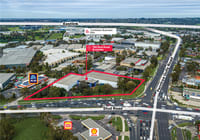
Rio Tinto signs up for carbon credits from $250m ag platform
Resources giant Rio Tinto has signed up acquire carbon credits generated by a $250 million farmland portfolio newly established by one of Canada’s biggest pension funds and Australia’s green bank.
The initiative comes amid expectations that carbon farming techniques will play an increasingly important role on the path toward to Labor’s 2035 emissions target. Major emitters, including Rio Tinto, may need to tap the carbon credit market for offsets if they fall short of their obligations to reduce emissions under the federal government’s Safeguard Mechanism.

The Meldora platform, as it will be known, has purchased its seed asset, a broad acre and irrigation farm of more than 15,000 hectares in central Queensland.
Investors in the platform are $550 billion Quebec-based La Caisse, which is contributing $200 million, and the Clean Energy Finance Corporation, which is investing $50 million, with asset manager Gunn Agri on board to operate the platform. The three players have previously teamed up on a separate sustainable agriculture venture.
The Meldora platform will focus on sustainable agricultural activities and large-scale environmental plantings that generate Australian carbon credit units.
Carbon credits backed by environmental planting – such as eucalypts and acacias – are seen as more reliable and of higher integrity. The method involves native vegetation being planted and maintained for a minimum of 25 years on some projects and as long as 100 years for others.
CEFC head of natural capital Heechung Sung said investment into natural capital, including sustainable agriculture, was critical to Australia achieving a low carbon future and its climate ambition.
“We’re targeting assets across Australia’s landscape that can support both farming – so income from traditional commodity production – plus the generation of high-quality environmental planting ACCUs [Australian carbon credit units],” Sung told The Australian Financial Review.
“We’ve focused on this particular methodology because it will generate a more resilient landscape to support farming practices. It is a method that brings local, native species back into the landscape.
“These investments are long duration. You won’t see an outcome immediately. They take many, many years to see the fruits of the early investment.”
Rio Tinto’s projects are among 219 of the country’s highest greenhouse gas emitting facilities required to reduce their emissions through the federal government’s Safeguard Mechanism. Two of Rio Tinto’s facilities emitted below its baseline threshold over 2023-24, effectively allowing it to receive credits from the government.
However, two other Queensland projects – bauxite mining at Weipa and its refinery at Gladstone – fell significantly short of its Safeguard Mechanism requirements, requiring it to surrender carbon credits.
To address such Safeguard Mechanism liabilities, the resources giant is investing into the carbon market to source high-integrity credits, backed by a variety of methodologies including savanna fire management, human-induced regeneration, and environmental planting.
As well, to reduce its reliance on the spot market in carbon credits, Rio Tinto has been investing in carbon developers, such as Australian Integrated Carbon and the Silva Carbon Origination Fund.

Canada’s La Caisse, formerly known as CDPQ, already has considerable interests in Australia with about $15 billion invested. The majority of that – $9 billion – is in infrastructure, including the Port of Brisbane, the Sydney Metro and Transgrid.
Emmanuel Jaclot, its executive vice-president and head of infrastructure and sustainability, said La Caisse was keen to position itself early in a growing market for high-quality carbon credits. The investment into ACCUs is its first in carbon credits globally.
“We believe that the only simple way to sequester carbon is through trees,” Jaclot told the Financial Review.
“Right now, there’s no framework to value this offsetting except what we’re trying to test here with the ACCU market in Australia which is very advanced, very robust and massively auditable and reliable.
“What we want to be very clear about is [that] not every carbon credit offset has the same value that we see here in the ACCUs in Australia.
“The fact we have CEFC and La Caisse working on this should give a lot of comfort that this is the highest standard that we were able to find.”











